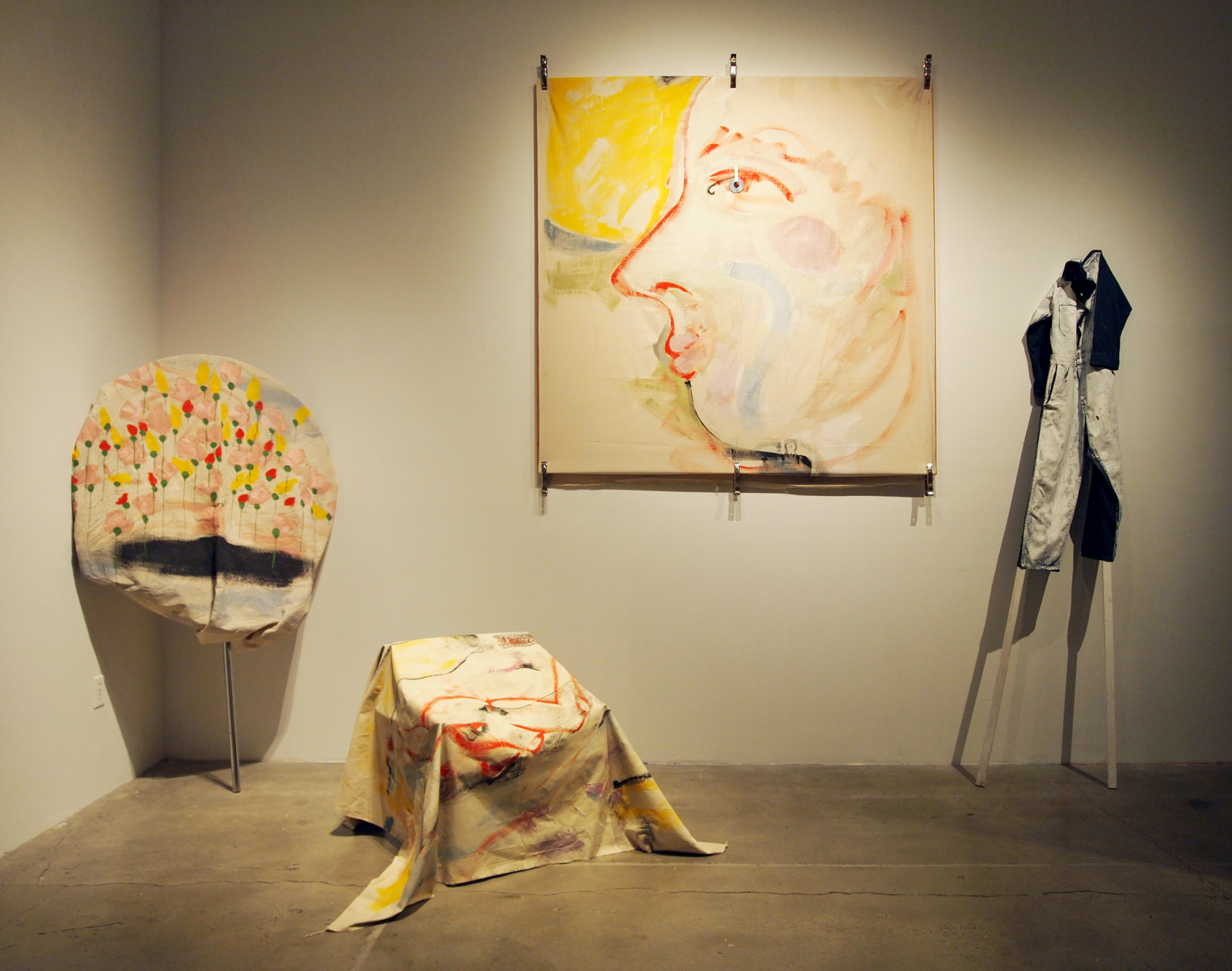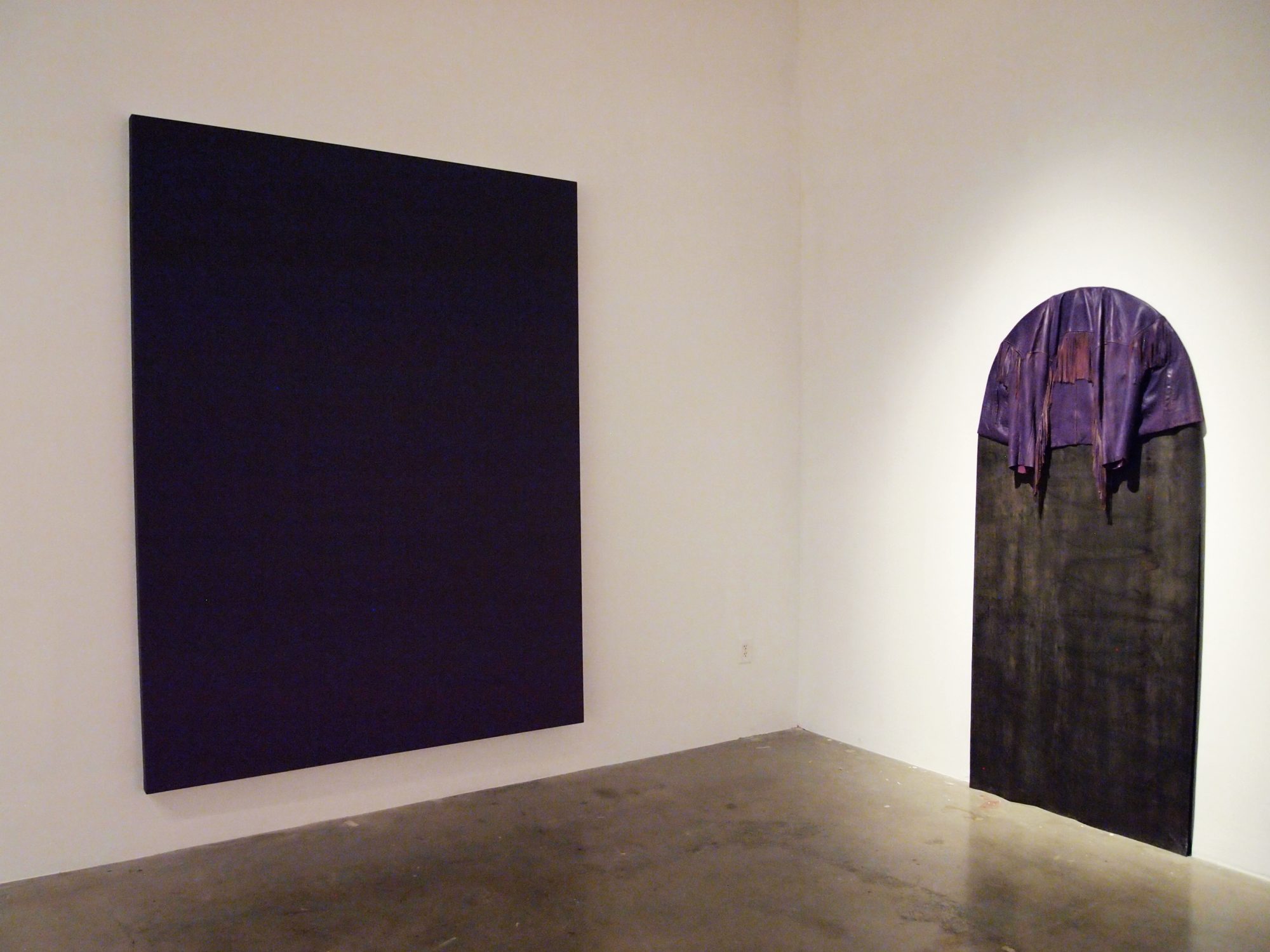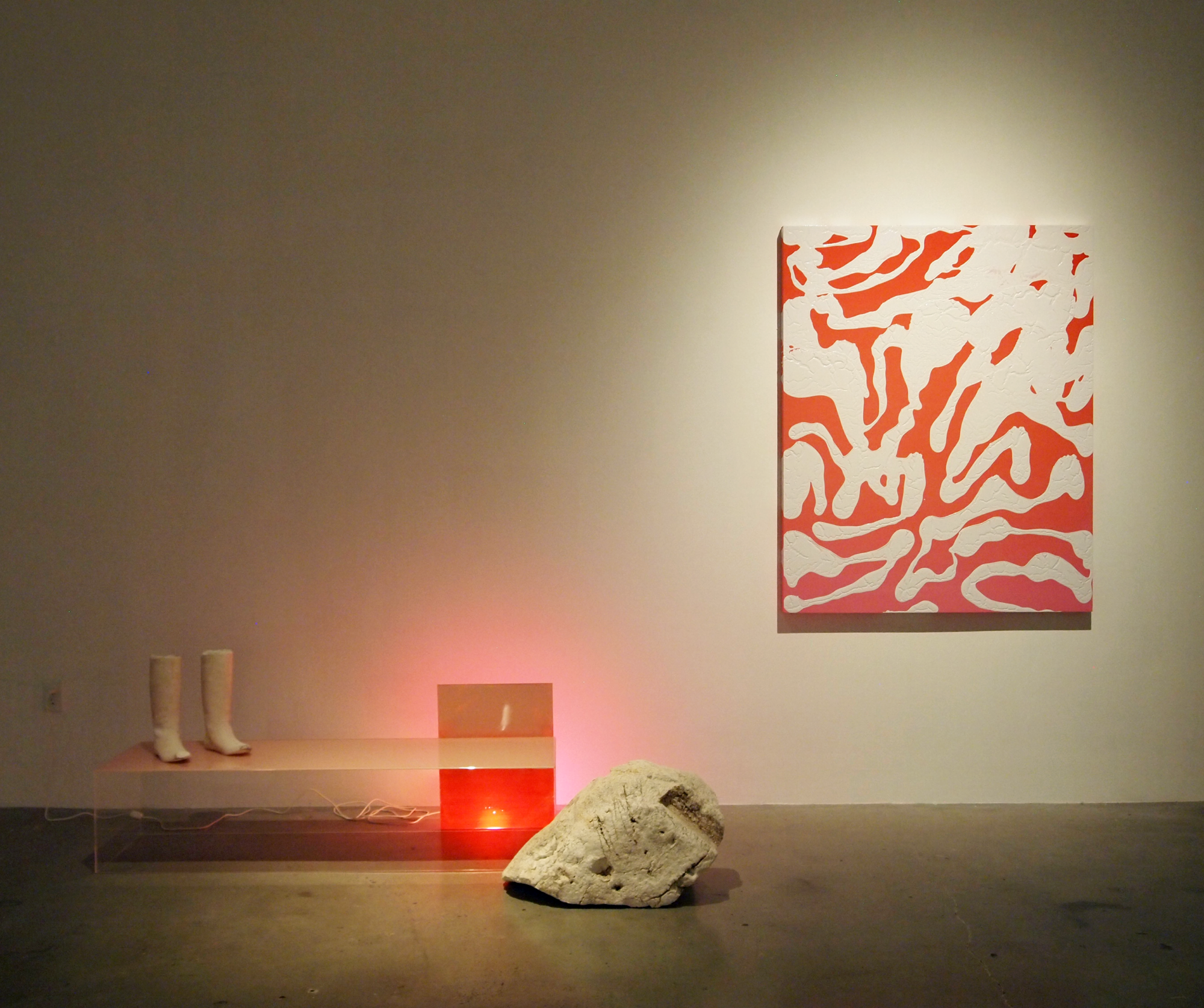Kirstin Mitchell: Miecznikowski
Miecznikowski, installation view, 2018 [courtesy of the artist and MOCA GA]
Share:
In Kirstin Mitchell’s Miecznikowski at the Museum of Contemporary Art of Georgia, darkness and obscurity counterbalance neon lights and pastel-painted canvases. Taking its title from Mitchell’s family name, the exhibition features paintings, sculptures, and mixed media pieces. Mitchell ambitiously loads the exhibition with themes as seemingly disparate as reclaimed Polish fantasy, blue-collar immigration stories, and the indivisibility of science and spirituality. These themes, spread across the 17 works, are disorienting but not overwhelming. Miecznikowski is more like a dream than a linear memoir, and, like a dream, it can be unpacked.
Throughout the exhibition, Mitchell embraces the recent loss of her father and applies Polish fantasy in an effort to reclaim a history withheld from her, using a mythic scope as a vehicle to convey visceral emotions. Chainmaile/Fishnet/Veil (2018), a 16-foot-tall spill of black rubber mesh that flows down from the ceiling into the middle of the space, might be the work that best blends mourning with wonder. This installation stands as a monumental mourning veil, its scope and form conjuring images of waterfalls of oil or a colossal knight’s suit of dark chain mail. Mourning is thus granted mythic proportions and all the accompanying weight. The installation demands attention, puddling across the floor and threatening to flood underfoot. Swords (2018) also has connections to fantasy. Covered in deep blue latex paint, the large canvas is slashed along the bottom in twelve sword shapes, so that the shorn canvas spills onto the floor. There is violence in how aggressively the sword-like marks are cut. They could be the claw-rakings of a large beast, but Mitchell is the wielder of the sword. The photograph Swordplay (2018), distributed through postcards, is the only traditional self-portrait; it shows the artist obscured by a dark swathe of fabric and holding a sword pressed into a foam stone, the strongest fantasy she manifests. Through exhibition texts, Mitchell explains that a family sword is decommissioned upon the passing of the last male heir. Despite this prescription, Mitchell is not putting down her sword. In its entirety, Miecznikowski functions as a deeply personal, fantastical portrait of grief.
The exhibition shifts attention to Venice, where the symbol of the bridge is introduced. The Bridge of Sighs (2018) features an ornate metal scepter leaning against a rectangular cushion of foam draped with folds of salmon-colored rubber. Its shape evokes the eponymous structure in Venice: a covered arch bridge, constructed in the 16th century, that connects the New Prisons to the interrogation rooms in the Doge’s Palace. Mitchell’s bridge is like an unfinished cake, with fondant still needing to be smoothed. This phantasmagorical bridge demonstrates how melancholy coexists with whimsy. Here, mourning is a sustained, unreleased sigh, time suspended until that breath can be let go and healing can begin.
Miecznikowski, installation view, 2018 [courtesy of the artist and MOCA GA]
Bright neon lights draw attention away from some of the exhibition’s darkest works, which hide at the periphery. In Golden Plane (2018), yellow paint partially covers the Plexiglas base under a golden wire basket. The basket is shaped like a cage, and bright light shines up through the base, giving the impression that the sun is imprisoned within, a bright spot of hope. Minkowski Space (2018) is a work that seemed to shrink away from the rest, tucked into its corner. A faded-purple leather jacket, bedecked with fringe, is hung over an arched door, painted black roughly, so that matte streaks remain. The title alludes to Minkowski spacetime, which represents the three dimensions of space applied to the fourth dimension of time. The piece is an open gateway into eternity, but it is difficult, as with much of the exhibition, to determine whether this force should be viewed as one of dark, light, or ambiguity.
The movement implied by contradicting physics in the exhibition is as enthralling as the works’ candy colors. With Flying Sword (2018), the shaft of an arrow appears to fly forward into a foreground that fades from sky blue to sand, evocative of the paradisiacal palette of Mitchell’s 2017 exhibition, Midnight at the Oasis. Coming for You (2018) is the answering pull to the thrust of that arrow, wherein a long length of rope emerges from a black, womb-like form in the center of a gray canvas. The rope is pulled up, toward the rafters, as if by a heavenly hand. If considered with Flying Sword, Coming for You becomes part of a playful and erotic pair. Arrows are common in Mitchell’s paintings and performance pieces, such as in One Shot (Momentum Exercise I) (2015), a performance piece in which Mitchell fired an arrow through nine canvas sheets. The action carries weight for its penetrative power—the arrow being a recurring phallic symbol—and the dark pit in Coming for You has the vague form of a vagina. Here, Mitchell performs both masculinity and femininity through painting. The suggested performances are suspended in time, so as to not allow complete closure, yet both achieve a degree of release through power (firing the arrow) and submission (pulling the darkness from its pit).
Loss becomes a dream of a lost fantasy, and time expands into infinity. Like a dream, dozens of themes and symbols become melded and confused, and a more complicated whole emerges. At its core, Miecznikowski is an exploration of immediate and historic heritage and a piercing portrait of grief. Hope is conveyed in sunspots and sighs. There are balances of powers: femininity and masculinity, spirituality and science, dark and light, as if so many pieces are bridging extremes to form navigable spectrums. There is resolution in Mitchell entirely embracing the sword and finally releasing her long-held sigh.
Miecznikowski is on view at the Museum of Contemporary Art of Georgia from July 14, 2018 — September 8, 2018.



